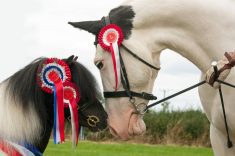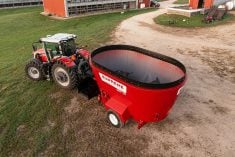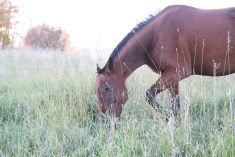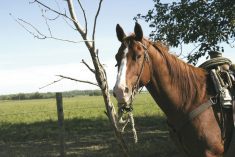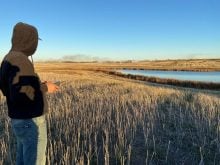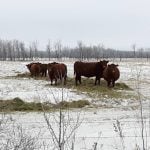Horse breeders in Manitoba are questioning why PMU horses are the only equines eligible for feed and animal transportation programs through AgriRecovery.
“There are a lot of horse breeders in the province of Manitoba who have foals on the ground that are just as big and contributing just as much, if not more, to Manitoba’s economy than mares producing PMU,” Diane David, executive director of the Manitoba Horse Council, said. “We think, in this instance, the Manitoba government should be giving all horse breeders the opportunity to apply for assistance.”
The Manitoba Horse Council represents clubs and individuals involved in equestrian sport.
Why it matters: Horse breeders and owners are facing many of the same drought stresses as other livestock operations, but the province says there are blurred lines between hobby and agricultural business to consider.
On Aug. 31, the province unveiled two AgriRecovery programs that it argued would shoulder the livestock sector’s immediate feed supply issues.
Under the Livestock Feed and Transportation Drought Assistance program, producers can apply for reimbursement of purchased feed, feed tests or feed transport for breeding herds. Beef and dairy cattle, sheep, goats, bison and PMU horses are eligible. The Livestock Transportation program, meanwhile, covers costs of bringing breeding stock to feed.
The announcement came a little under a month after producers received confirmation that AgriRecovery would be triggered this year, a reaction to one of the worst droughts in recent memory. The federal and provincial governments eventually settled on $155 million to cover all Manitoba AgriRecovery programs.
A number of PMU operations have taken advantage of the programs so far, according to the province.
Manitoba Agriculture and Resource Development Minister Ralph Eichler said horses were not seen as a priority by the stakeholder group helping to develop those programs. That group included organizations like the Manitoba Beef Producers, Keystone Agricultural Producers and Association of Manitoba Municipalities.
“They wanted to focus mainly on the cattle, the bison and the elk and the sheep and the goats,” he said, “but they did talk about horses and we’ve sent it back to them.”
At the same time, Eichler added, it will be “difficult” to differentiate “between what is a personal need and that of a business.”
Horse breeding stock is the source of much of that sticking point, he said, acknowledging that he has heard some push-back from horse breeders on their exclusion from the program.
“You’ve got a lot of people invested with 10 horses that have literally hundreds of thousands of dollars tied up, but still wouldn’t qualify,” he noted. “So where do you end with it? So that’s the challenge.”
Current programs require any producer of any eligible livestock type to have at least 10 animals.
Overlooked
It is not the first time that horse owners have been frozen out of livestock aid, according to Meighan Janzen, who, along with her husband, operates MK Livestock near Fraserwood, a community west of Gimli.
“This isn’t the first year that we’ve had hay problems,” Janzen said. “There were other years for sure that we were denied because we’re not cattle.
“It would have been nice, back then, to even get half of what the beef producers get — something just to help with trucking,” she added.
But while Janzen is not a beef operation, she argued, she is a livestock breeder, as are her longtime horse breeder parents, the historical proprietors of Silvertip Paint & Quarter Horses.
Drought conditions, mixed with quality requirements for horse feed meant that much of her feed came from Quebec this year, she said, something that required costly freight.
“It would have been nice to get some of that back,” she said.
David said they have not heard many of their members complaining of specific programs, but they have heard plenty about how drought has impacted those members this year.
High feed cost has been a repeat concern, she said, and one that has been compounded by COVID-19 for stables that draw income from lessons and other in-person programming.
There are horse owners unable to overwinter their animals due to that high feed cost, David also noted, and animals that are sold are often drawing a lower-than-expected price.
Both David and Janzen also noted the higher feed quality requirement for horses compared to beef cattle, something they argue also plays into the financial stress of the drought.
Between 2019 and 2021, David estimated horse hay prices increased anywhere from 40 to 45 per cent.
Back to the table?
The province may go back to review horse eligibility, Eichler said in an early-December interview, adding that the recently unveiled AgriRecovery program for herd rebuilding has taken up much of the department’s attention thus far.
In early December, the province launched the Herd Management Drought Assistance program, targeted to recover herds that were deeply culled as the result of drought. That program covers replacement for breeding females of beef cattle, bison, sheep, goats and elk.




